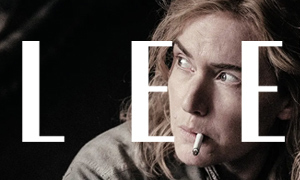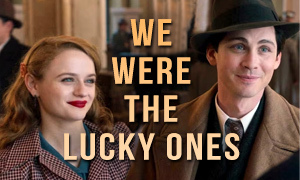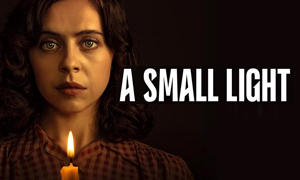The Survivor: History vs. Hollywood
Ben Foster
Born: October 29, 1980
Birthplace:
Boston, Massachusetts, USA
Harry Haft
Born: July 28, 1925
Birthplace: Bełchatów, Poland
Death: November 3, 2007, Pembroke Pines, Florida, USA (cancer)
Bio: Boxer and Holocaust Survivor
Vicky Krieps
Born: October 4, 1983
Birthplace:
Luxembourg City, Luxembourg
Miriam Wofsoniker
Born: August 10, 1928
Death: 2019, Pembroke Pines, Florida, USA
Bio: Harry Haft's Wife
Danny DeVito
Born: November 17, 1944
Birthplace:
Asbury Park, New Jersey, USA
Charlie Goldman
Born: December 22, 1887
Birthplace: Warsaw, Poland
Death: November 11, 1968
Bio: Rocky Marciano's Trainer who Helped Harry Haft
Saro Emirze
Born: September 9, 1977
Birthplace:
Frankfurt am Main, Hessen, Germany
Peretz Haft
Birthplace: Bełchatów, Poland
Bio: Harry Haft's Brother
Anthony Molinari
Born: May 9, 1974
Birthplace:
Worcester, Massachusetts, USA
Rocky Marciano
Born: September 1, 1923
Birthplace: Brockton, Massachusetts, USA
Death: August 31, 1969, Newton, Iowa, USA (plane crash)
Bio: Future World Heavyweight Champion
How long did Harry Haft spend in the Nazi concentration camps?
The Survivor true story reveals that during the Nazi occupation of Poland, Harry Haft was sent to his first concentration camp when he was a month shy of 16, the age he had planned to marry his childhood sweetheart, his girlfriend Leah. "[Harry Haft] survived five years in six different concentration camps," said his son, author Alan Scott Haft, who wrote the 2006 book on which the movie is based. Harry Haft's girlfriend's whereabouts became unknown to Harry and he would spend years trying to locate her, both during and after WWII.
Did Harry Haft get caught for trying to steal diamonds?
Though it's not shown in the movie, while working in the concentration camp Auschwitz II-Birkenau sorting prisoners' possessions, including clothes, silver, gold, and other valuables, Harry stole diamonds for a German officer named Dietrich Schneider, who he had known from back home (Dietrich Schneider is a fictional name used in the book and movie. Harry couldn't remember his actual name). He deposited the diamonds into a bottle and hid the bottle in his bed.
During a barracks inspection, it was observed that his bed wasn't made right (Harry said that his bed was made correctly, but for some reason, the soldiers knew to go straight to it). When the inspector touched his bed, the bottle of diamonds fell out. Though interrogated and beaten, he didn't tell them that he had been stealing the diamonds for Officer Schneider. As punishment, they assigned him to the building that housed the Strafkommando and he was beaten severely. "You live two days or three days tops," recalled Harry of the unit. Luckily, Schneider saved him by putting him on a transport to the camp at Jaworzno (a sub-camp of Auschwitz). The HBO movie changes much of this and has Officer Schneider step in and save Harry from being executed for beating on a German soldier who was about to kill another prisoner.
Is The Survivor based on Harry Haft's son's book?
Yes. HBO's The Survivor movie is based on his son Alan's 2006 book Harry Haft: Survivor of Auschwitz, Challenger of Rocky Marciano. Several years later, German cartoonist Reinhard Kleist adapted the book into the acclaimed graphic novel The Boxer.
Did Harry Haft labor in a coal mine while he was at the concentration camp Jaworzno?
Yes. Harry Haft endured hard labor in the coal mine at Jaworzno, a concentration camp that was considered a sub-camp of Auschwitz. Each month, roughly 200 Jewish prisoners who could no longer work were transported from the camp to the gas chambers at Auschwitz II-Birkenau, resulting in thousands of deaths. The brutality of the camp itself appears to be depicted accurately in the movie. Starvation, disease, and physical abuse were common.
The Survivor fact-check confirms that after having spent roughly a year at Jaworzno, the German officer who had helped Harry, Dietrich Schneider, arrived at the camp. He gave Harry extra food to fatten him up. He also saved Harry's life when Harry broke his foot while working at the mines and was on the verge of being sent to the gas chamber at Auschwitz II-Birkenau (the movie changes this to a guard breaking Harry's hand).
Did a German officer encourage Harry Haft to become a boxer in the camps in order to survive?
Yes. The SS officer who had been protecting Haft and feeding him extra had taken note of Haft's strong physique and told him he was to become a boxer in the camp. Haft already had some basic boxing training as a youth in Poland. In the film, the German officer is named Dietrich Schneider and is portrayed by Billy Magnussen (as stated earlier, the real Harry Haft did not remember the officer's name). The Survivor true story confirms that like in the movie, the brutal matches gave Haft the opportunity to continue to survive, while at the same time entertaining the officers. As a successful fighter, he was also given lighter duty in the coal mines.
It's historically accurate that the high-ranking German officer Dietrich Schneider was helping Harry Haft so that Haft would vouch for his kindness when American and Russian forces determined his fate after the war. By that point, Officer Schneider could see that the war was going very poorly for Germany. The movie portrays Officer Dietrich Schneider to be more heartless and vindictive than the book describes him as being in real life.
How many bare-knuckle boxing matches did Harry Haft compete in while he was in the Nazi concentration camp?
In researching how accurate is The Survivor movie on HBO, we learned that while at the Nazi concentration camp Jaworzno, which was located at a coal mine north of Auschwitz, Harry Haft fought in a total of 76 bare-knuckle matches for the amusement of the SS guards. Like in The Survivor HBO movie, Haft boxed in three to four matches against other prisoners on Sundays, and the matches ended when one fighter could no longer get up.
"It was actually boxing to the finish," Haft recalled later in life. "One of us had to lay down. It was not professional fighting or amateur fighting. It was just entertaining the Germans. I knew how to do it and I survived." The prisoners who lost often faced execution (USC Shoah Foundation). "In the camps, the fight was to the finish. The loser wound up in the hospital, and if he didn't get well after a few days, he went out on the next transport to Auschwitz [to the gas chambers]" (Against All Odds).
Was Harry Haft racked with guilt over the matches he won in the concentration camp?
Yes. Each Sunday for several months, Harry Haft fought three to four opponents for the amusement of the German officers. As a result of his winning streak and fighting prowess, the officers nicknamed him "The Jew Animal." Haft understood that winning in the camps equated to survival. Like in the film, the men who lost to Haft were often executed by the Nazis. It is believed that more than 70 men could have been put to death as a result of losing to Haft, a notion that riddled him with guilt for the rest of his life.
Upon boxer Harry Haft's induction into the National Jewish Sports Hall of Fame in April 2007, several months before his death, he was asked if he had any regrets. His son Alan said that his father, the Holocaust survivor, looked down at his battered fists and replied that "his regrets were the lives that passed through his hands." -Ozy
Does actor Ben Foster physically resemble Harry Haft?
Not exactly. This is most noticeable during The Survivor's concentration camp scenes, which are central to the film. While he did lose the weight for the scenes, Ben Foster is nearly twice the age Haft was at the time. Haft was barely out of his teens toward the end of his time in the camps. In the movie's defense, the story does span several decades, but it would have perhaps been more effective to cast a younger actor and age his appearance with makeup for the less pivotal scenes decades later. Ben Foster's character is aged with makeup in the film, but he is aged into his fifties for the film's scenes that take place in 1963. The real Harry Haft was only 38 in 1963.
In the book, Haft is described as being "fat" while he was under the watch of SS Officer Dietrich Schneider at the concentration camp at Jaworzno, so much so that Harry Haft's brother Peretz didn't recognize him at first. In the movie, Ben Foster's character is rail-thin. This seems to be an exaggeration of The Survivor true story, given that the book states he was fattened up by sausages that were given to him by Officer Schneider. It's also possible that the book's notion of "fat" is in comparison to Haft's severely emaciated fellow prisoners. By that standard, the movie seems somewhat accurate then.
Why does the film leave out the cannibalism that Harry Haft observed firsthand in the concentration camps?
When Harry Haft and his brother Peretz were relocated to a concentration camp in Flossenbürg, Germany, they endured several terrifying nights locked in a barracks with starving prisoners who began to kill and eat each other to stay alive. To survive, Harry stayed huddled close to Peretz and pretended to be sleeping. Though it is included in Harry's son Alan's book that inspired the movie, the filmmakers felt that it was too intense for the screen. "That was such a taboo subject," says Alan Haft, "you didn’t talk about it. But my father wanted to make it known that this is what people resort to when they’re starved and put into extreme circumstances. It’s a total breakdown of civilization at that point." -Ozy
Did Harry Haft escape the Nazis during a death march to Germany?
Yes. As the Soviet Red Army advanced on the mining concentration camp Jaworzno north of Auschwitz, the Nazis shut down the camp and forced thousands of its surviving inmates to march west to Germany. Exploring The Survivor fact vs. fiction reveals that of the several thousand Jews who left Jaworzno, only thirty men were still alive when they reached the concentration camp in Flossenburg, Germany, near the Czech border. Eventually, they left the camp when Flossenburg was being bombed. They were loaded onto trucks for a four-day trip to Poland and a concentration camp called Gross-Rosen. After several weeks, Gross-Rosen was evacuated and Harry and his brother Peretz found themselves on a two-day train trip to a large airfield just outside of Amberg, Germany where they worked cleaning airplanes and helping repairmen. All of the camps after Jaworzno are left out of the movie.
In April 1945, they were marched out of the camp at the airfield when the allies started bombing it. Along the way, they could hear gunshots coming from the back of the line. Harry Haft urged his brother to run with him, but Peretz refused. Harry ran with another man, who ended up being shot as they made their way to the top of a hill. Harry pushed his mortally-wounded friend into a nearby foxhole and he got in beside him. When the German soldiers came to finish them off, Harry had positioned himself under his friend's bloody body and feigned death. He was finally free.
Did Harry Haft kill a German soldier while he was on the run?
Yes, but it wasn't Officer Dietrich Schneider, who was not the villain that the movie makes him out to be. The Survivor movie fact-check reveals that after escaping, Haft killed a bathing SS man using the man's own handgun. He first tried to use the man's rifle but missed. As the naked man ran toward him from the river, Haft grabbed the man's handgun and emptied the chamber into him. Filled with desperation and rage, Haft then used the butt of the rifle to pulverize the man's skull. He put on the man's uniform and eyepatch, which he used as a disguise.
Did Harry Haft kill an elderly German couple and a middle-aged German woman?
Yes, but neither of these events are depicted in the film. The elderly couple harbored Harry Haft in their small farmhouse, believing he was an injured German soldier who had been separated from his unit. Haft killed the couple the following morning after the husband began to badger him with questions about his eyepatch and whether he was German. Haft feared that they would turn him in to German authorities. He collected food from their kitchen and ran off and hid in the Bohemian Forest for weeks.
Eventually, he ran out of food and searched for another farm. He again had the same plan of telling the owners that he was an injured German soldier who had been separated from his unit. When a middle-aged woman answered the door, she could immediately see that he was an imposter and called him out for it. "You're not a soldier. You're not even German," she told him. Stricken with fear that she would turn him in, he went into a blind rage and pulled out his revolver and shot the woman. He headed to the kitchen to steal food when he heard a noise. He found a boy of about 12 years of age, presumably the woman's son, hiding in a bedroom closet. Haft told the boy to stay in the closet and then he quickly fled the house.
Was Harry Haft found by a group of American soldiers?
This is another event not shown in the movie. One morning while hiding in an abandoned, half-collapsed farmhouse on the outskirts of the city of Regensburg, Germany, Haft noticed a group of men approaching the structure. He armed himself with his rifle and revolver. Rather than be captured, he was prepared to die fighting. Suddenly, he spotted an American flag. He left the rifle in the farmhouse and put his hands up as he walked outside. He dropped to the ground and used his finger to draw the Star of David in the dirt. He showed the soldiers the numbers that had been tattooed on his forearm. He was finally safe.
When did the Harry Haft come to the United States?
The Survivor movie true story confirms that after sending a letter to his Uncle Samuel Haft in America, the real Harry Haft emigrated to the United States in 1948 at age 23 aboard the ship Marine Marlin (pictured below), a troopship the U.S. Army was using to transport refugees. Harry embarked on the voyage from Bremerhaven, Germany to New York City using a fake identity. He came to America hoping to fulfill his dream of becoming a prizefighter.
How long did Harry Haft's boxing career last?
After surviving by boxing more than 70 fellow prisoners in a Nazi concentration camp, Haft went to live in a Displaced Persons' Camp in Austria after the war, which was operated by the occupying U.S. Army. He boxed competitively in Germany, winning the Amateur Jewish Heavyweight Championship in January 1947 in a competition organized by the U.S. Army in post-war Munich. General Lucius Clay presented him with his trophies after the bout, a cup for claiming the heavyweight title and a bronze statue of Apollo for being voted the best boxer of the tournament.
With dreams of becoming a boxing champion in the United States, Haft emigrated to America in 1948 at age 23, initially staying with his Uncle Samuel's family in Paterson, New Jersey. When his Aunt Sadie asked him why he would want to box after having gone through so much punishment already, Haft replied, "After everything I've been through, what can some guy with gloves do to me?" He boxed as a light heavyweight in 1948 and 1949. As detailed below, though he initially found success, his career took a turn and he endured several significant losses before hanging up his gloves in 1949 after a bout against Rocky Marciano, the future world heavyweight champion.
Did Harry Haft engage in public prizefighting to attract the attention of his childhood sweetheart, Leah?
In The Survivor HBO movie, Harry engages in increasingly high-profile boxing matches to get the attention of his childhood sweetheart, Leah (Dar Zuzovsky), who he lost during the war. He then hopes that by making the decision to fight Rocky Marciano (Anthony Molinari), a match that he stands little chance of winning, his name will get out to the world. Perhaps if Leah is still alive, she'll come find him.
In exploring how accurate is The Survivor movie, we confirmed that this is very much in line with what Harry's son Alan states in the book. Getting his name in the newspapers was a way for Harry to let the world know he had survived the concentration camps. He hoped that family and friends would recognize his name and come find him, especially Leah, Harry Haft's girlfriend with whom he had lost touch after he was taken to the camps. In the book, Leah's last name is fictionalized as Pablanski. In real life, when Harry told his story to Alan in 2003 for the book, he could no longer remember Leah's last name.
Did Harry Haft win his first 12 bouts in the U.S.?
Yes. After emerging victorious in his first 12 bouts, Harry lost to the Irish-born Pat O'Connor, a more experienced boxer, on January 5, 1949.
Is Peter Sarsgaard's character, Emory Anderson, based on a real-life reporter?
No. Peter Sarsgaard's character in the movie, reporter Emory Anderson, convinces Harry Haft (Ben Foster) to share his story of his time spent living and boxing in the concentration camps. He tells Haft that going public with the story will get his name out to the world. Believing that it might help Leah to find him, Haft agrees. The publishing of Anderson's article sparks a negative reaction from the Jewish community, who brand Haft a "traitor."
There was no real-life Emory Anderson. He appears nowhere in Harry Haft's son Alan's book. In fact, it would be decades before Harry Haft was willing to talk openly about his time in the concentration camps. In 2003, at age 77, he opened up in detail for his son Alan's book. Prior to that, he had briefly talked about his time in the camps in several 1990s interviews. Unlike the movie, he never opened up to his son Alan when his son was a boy.
Did Harry Haft lose his final match to Rocky Marciano?
Yes. As in the movie, Harry Haft (21-13-5, 8 KO) faced an undefeated Rocky Marciano (49-49-0, 43 KO) on July 18, 1949 in what would be Haft's last match as a professional boxer. The match took place at the Rhode Island Auditorium in Providence. Haft held his own for a fairly even first two rounds, but the future heavyweight champ Marciano defeated him by way of knockout in the third after landing a combination of punches to the stomach and jaw. Marciano would go on to have an undefeated professional career.
The true story reveals that in real life, there were less than 1,700 people on hand to see the match in an auditorium that could hold 5,300. This was largely due to the fact that sportswriters had accused Marciano of fighting a string of weak opponents to pad his record. Of his 17 professional fights prior to that night, Marciano had won 16 of them by way of knockout. -Ozy
Did the mafia convince Harry Haft to throw the match against Rocky Marciano?
In the years that followed the match, boxer Harry Haft told everyone who asked about his fight against Rocky Marciano that it had been rigged. In his 2006 book, his son Alan wrote that three shady-looking, elegantly-dressed men from the mafia came into his father's dressing room prior to the match and told him that if he didn't throw the fight, they would kill him. This situation of real-life danger causes his repressed, traumatic memories to come to the surface and he flashes back to his whole life up until that point. These memories of his past make up much of the next 200 pages of the book. This is obviously a heavily fictionalized moment that is ready-made for a movie script.
In the book's afterword, Harry Haft's son Alan admits that he never believed his father's story of being threatened to throw the fight against Marciano. "I never believed him," states Alan. "I saw it as an excuse for why he peddled fruit from a pushcart and from stores in crime-ridden Brooklyn ghetto neighborhoods." The movie leaves out the mafia and aligns itself more with Alan's perspective.
How did Harry Haft meet his wife, Miriam Wofsoniker?
In real life, Harry Haft met Miriam Wofsoniker right after the end of his boxing career. He had just lost his job as a hat blocker after the owner died suddenly in an automobile accident. Low on funds, Harry was forced to move from Brighton Beach to a less-expensive room in a second-floor apartment in Brownsville owned by a widow named Mrs. Lipstein. Miriam, who was 20 at the time, lived below in an apartment with her parents. One evening, Harry went to see a movie and came back to his room around 9:30. He assumed Mrs. Lipstein was asleep, so he locked the door with the chain and went to bed.
Suddenly, the phone rang and woke him. It was Miriam Wofsoniker from the apartment below. She introduced herself and told him that Mrs. Lipstein had returned and couldn't get in. They talked for a moment, and prior to hanging up, Harry told her that he had noticed her and had been trying to meet her for weeks. He asked her out for the following day, and after a brief hesitation, she said yes. They got to know each other quickly, and in less than a week's time, Harry asked her to marry him. Miriam said yes. They kept it a secret from Miriam's parents and were married at the Kings County Courthouse on November 19, 1949. After breaking the news to Miriam's parents, the Wofsonikers insisted on a Jewish wedding. The ceremony and reception took place on March 22, 1950.
What did Harry Haft do after he retired from boxing?
During our investigation into The Survivor true story, we learned that after losing to Rocky Marciano and retiring from boxing, Harry Haft married Miriam Wofsoniker. They lived in Brooklyn where Harry pursued several different jobs, including working as a professional driver and eventually as a business owner, opening several fruit and vegetable stores along with selling from a pushcart. Harry and Miriam had three children: a son named Alan Scott Haft (born 1950), a daughter named Helene Haft, and a third child named Marty Haft (a boy). After their children became adults, they were blessed with six grandchildren. Harry Haft and his wife Miriam moved to Florida after he retired. He passed away from cancer on November 3, 2007. Miriam passed away twelve years later in 2019.
Did Harry Haft ever find Leah in real life?
Yes. Like in The Survivor HBO movie, Harry Haft finally found his long-lost love Leah in 1963, more than 20 years since he had last seen her. At that point, Harry and his wife Miriam had three children. He had learned that Leah was living in Miami and he surprised his family with a trip to Miami Beach (the movie changes Leah's location to Tybee Island, Georgia). They traveled by train, and after arriving at their hotel, he spoke to Leah's husband Michael on the phone. Michael was cryptic and said that Leah couldn't talk, but after hanging up and telling her that Harry (Hertzko) called, Michael called back and said that she wanted to see him. Harry rented a car and he and his son Alan went to visit Leah the next day.
Harry learned that Leah and her husband Michael had two children, a teenage daughter named Sarah and a son named David. He also discovered that Leah was suffering from terminal cancer. A frail Leah took Harry into the backyard and they talked alone for some time. Though heartbreaking, the visit provided Harry with some closure after all those years of not knowing what happened to Leah. It was the last time he saw her. During his conversation with Leah in the movie, she tells him that she saw a picture of him in the newspaper years earlier on the morning after her wedding. We found no evidence she told him that in real life.
Did Harry Haft's wife Miriam excuse her husband's abusive behavior?
Yes. Harry Haft's son Alan said that his mother was protective of her husband and forgave him for his abusive behavior, which she believed was the result of his difficult past.
Did Harry Haft suffer from PTSD after the war?
Yes. Harry's son Alan says that while growing up in the 1950s, he couldn't really talk to his father because he could "explode at any time." He said that his father had "psychotic episodes" that sometimes culminated in violence. "One time, he broke every window in the house," says Alan. "And I couldn't object to anything, otherwise I'd get beaten. So it was crazy." Alan admits that he went somewhat easy on his father in the book since his father was still alive at the time. However, he tries to not be too critical of his father and takes into consideration his father's experiences. -Ozy
"He never managed to escape the memories of the concentration camps," wrote Alan of his father. "He has struggled with nightmares throughout his life, and in response to any personal or family crisis, he has threatened to kill himself. ... By today's standards, I was a battered child." Harry Haft never talked to his son about his experiences in the camps until September 2003 when he gave Alan a detailed account for the book.







